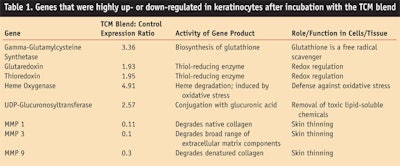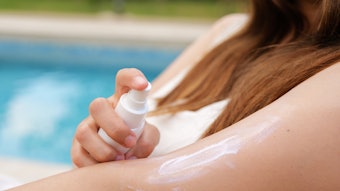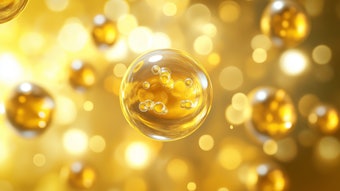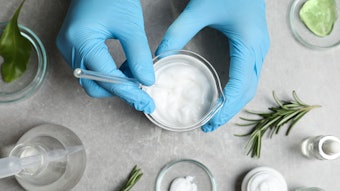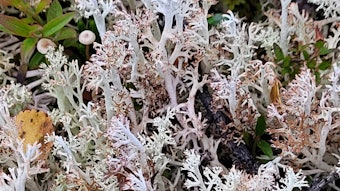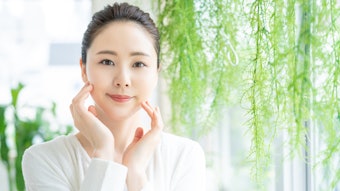Traditional Chinese medicine (TCM) is a holistic approach to healing that developed in China about 3,000 years ago and that typically includes therapies such as acupuncture, qigong exercises and herbal medicine. It is highly respected as a means to treat skin disorders and is especially well-perceived by European and Eastern cultures. Believing in the efficacy of TCM, the authors collaborated with expert Severin Bühlmann, PhD, to incorporate this approach into an herbal blend to treat dry, sensitive skin that is prone to psoriasis. The formula also was designed to induce an anti-inflammatory and soothing effect in skin.
Herbal Activity
Anti-inflammation: The anti-inflammatory activity of Lonicerahttp://dev.www.cosmeticsandtoiletries.com/articleaddons/214202851.html?KeepThis=true&TB_iframe=true&height=450&width=650 japonica is well-documented in the literature. It is an important Chinese herb that is used to treat inflammatory skin disorders. Ochnaflavone is a biflavonoid and the pharmacologically active compound found in Lonicera. It has been shown to block the inflammation pathway at two points: at the transcription factor NF-ΚB, and at the enzyme cyclooxygenase-2.1,2 NF-ΚB, a regulator of gene activity, is responsible for the formation of gene products that are used to induce an inflammatory response. When NF-ΚB is blocked, the typical inflammatory reaction to stimuli such as UV light or free radicals is also blocked. Cyclooxygenase-2 synthesizes lipid mediators called prostaglandins that are used to develop inflammation by, for example, increasing local blood circulation. Cyclooxygenase-2 is the target of many pharmaceuticals for relief from pain and inflammation.
Antibacterial activity: Xanthium sibiricum contains xanthanolide sesquiterpenes—pharmacologically active compounds that are reported to have antibacterial activity.3 In addition, Cyperus rotundus has been shown to exert antibacterial effects as well as strong antioxidant activity.4 While the individual activity of each of these Chinese herbs is important, the final activity results from this specific combination. Such combinations or blends are found in traditional recipes of Chinese medicine.
Combining these anti-inflammatory and antibacterial activities, the authors developed an herbal TCM blenda comprising the aqueous extracts of Lonicera japonica flowers, Xanthium sibiricum fruits, and Cyperus rotundus roots. The efficacy of this TCM blend was tested in vitro by gene array analysis and in vivo in a clinical trial.
Gene Array Analysis
To determine the efficacy of the TCM blend, gene array analysis based on a DNA microarray technologyb was performed in vitro using keratinocytes. This method analyzes the effects of certain compounds on the metabolism of cells. It is a well-established technique that uses chip and robotics technology to measure the activity and expression of hundreds to thousands of different genes in one experiment.
The DNA microarray is a solid chip, about the size of a fingernail, onto which thousands of prepared microscopic spots of DNA oligonucleotides are arrayed from a specific DNA sequence. Each spot contains picomoles of that specified sequence; in this case, a short section of a gene. This particular array contained 1,308 genes that are known markers for disorders in: the skin barrier, the extracellular matrix, DNA repair, signaling, detoxification, inflammation, skin cancer and other skin disorders.
The in vitro test was performed according to the following protocol. Normal human keratinocytes were taken from the same donor and incubated for 24 hr either in the TCM blend or in the medium only, which served as a control. Since RNA contains information on the activity of each individual gene, the cells of both cultures were centrifuged and the RNA of the cell pellets was isolated. The RNA of the control culture was labeled with a green fluorescent dye; the RNA from the TCM-treated culture with red fluorescent dye (preparation of the cDNA).
The DNA array was incubated with both labeled RNA preparations. Laser scanning was then performed on the DNA array (see Figure 1). A green fluorescent spot indicated the gene was less active and thus down-regulated in the presence of the active ingredient. A red fluorescent spot showed that the gene was more active or up-regulated. In the case of no difference in gene activity between the control and the TCM-treated culture, the corresponding spot was fluorescent yellow.
The results of the gene array are summarized in Table 1. Only those genes that were highly up-regulated (> 1.9), or highly down-regulated (< 0.4) were taken into account for the efficacy evaluation. The highly up-regulated genes could be grouped by researchers into one main cellular function—protection against free radicals, oxidative stress and toxic molecules, and include:
- Gamma-glutamylcysteine synthetase is the enzyme used for the synthesis of glutathione, an important cellular antioxidant. Glutathione is a tripeptide with the sulfhydryl group of cysteine as its active site. In the reduced state, the sulfhydryl group can provide a reducing equivalent to unstable reactive oxygen species.
- Glutaredoxin and thioredoxin are both proteins that also contain sulfhydryl groups of cysteine residues as active sites. They compose an enzymatic system to deliver reducing equivalents or electrons.
- The heme oxygenase enzyme catalyzes the degradation of heme, an iron-containing molecule that is important for binding oxygen in hemoglobin. Bilirubin, a degradation product of heme, is an efficient scavenger of reactive oxygen species. Thus, the up-regulation of heme oxygenase is therefore a means to protect cells against oxidative stress.
- The enzyme UDP-glucuronosyltransferase helps in the neutralization of fat-soluble toxic molecules such as drugs or environmental toxins. The enzyme increases their solubility in water by adding a glucuronic acid sugar molecule to them. The increased resistance against toxic molecules clearly helps to protect against skin irritation.
The up-regulation of these genes was not surprising because free radicals and oxidative stress are classic triggers for inflammatory reactions in the skin. Again, the most down-regulated genes encode three enzymes of the same family, the matrix metalloproteinase (MMP) family that comprises enzymes responsible for degradation of the extracellular matrix. MMPs play an important role in the metabolism of matrix components such as collagen and elastin and are essential, for example, in wound healing. However, it is also known that they are predominant in aged skin and lead to an imbalance in the synthesis and degradation of matrix components, causing skin to lose its firmness and elasticity. MMPs also are involved in photoaging of the skin; exposure of skin cells to UV radiation leads to the up-regulation of the expression of MMP genes.5
Inhibition of the expression of MMPs or of their enzymatic activity is the mechanism of action of many actives against skin aging, including the TCM blend under investigation. The results in Table 1 show a drastic down-regulation of MMP genes in keratinocytes after incubation with the TCM blend, suggesting its protective/antiaging efficacy.
Anti-irritancy Clinical Trial
The soothing and anti-inflammatory efficacies of the TCM blend were tested with 20 subjects using the anionic surfactant sodium dodecyl sulfate (SDS) as the skin irritant. This is a well-known skin irritant that easily penetrates the skin and disrupts the skin barrier. A protocol was developed to test for regenerative as well as protective activities. First, an aqueous solution of 2% SDS was applied under occlusion for 24 hr to a test site on the inner side of the forearm. The TCM blend, a placebo cream, and a 5% TCM blend cream were then applied after the first SDS application, twice daily for nine days (see Formula 1).
The resulting inflammatory response and its gradual disappearance during nine days was documented by measuring skin hydrationc and skin rednessd, then the SDS solution was applied again for 24 hr. On day 10, hydration and redness were measured to detect for possible protective effects of the TCM ingredient.
The placebo carrier cream (see Formula 1) contained a lamellar-organized lipid fraction comprising hydrogenated phospholipids, and despite the richness of the carrier cream, the cream containing the TCM blend still showed clear advantages over the placebo. For example, the redness of the zone treated with the active ingredient declined significantly faster after SDS application, and also showed less redness and thus better protection against the second SDS application (see
Figure 2). Compared to the placebo, the effect of the TCM test cream on skin hydration was even more pronounced (see Figure 3). After barrier disruption, application of the cream containing the active ingredient resulted in a faster, stronger moisturizing effect compared to the placebo, with highly significant protection against the second SDS application.
Conclusion
A cosmetic blend based on historic TCM ingredients was designed to treat dry, easily irritated skin. Its effects on keratinocytes were tested in a gene array experiment measuring 1,308 markers for skin disorders. Results suggest the TCM blend offers strong antiaging potential.
Free radicals and oxidative stress are triggers for inflammatory reactions in the skin and over time, they become factors in normal and premature skin aging. The oxidation of proteins is especially regarded as a cause of cellular aging because oxidized proteins lose their activity and tend to form aggregates. They also cause the loss of cellular function and lead to tissue impairment.6 The sulfur-containing side chains of cysteine and methionine are the principal targets of protein oxidation.
The tested TCM blend was found to stimulate the cell’s own defense system by up-regulating the thiol-reducing enzymes glutaredoxin and thioredoxin; it therefore can be concluded that the blend represents a means to prevent protein oxidation and to regenerate existing oxidized proteins.
Aged skin is characterized by an imbalance in the extracellular matrix: the biosynthesis of matrix components is reduced and their degradation is increased, resulting in a loss of elasticity and thinning of the skin. The tested TCM blend counteracted this tendency by inhibiting the formation of extracellular matrix-degrading enzymes. It also was shown to protect against premature skin aging by reducing oxidative damage and the break down of collagen.
TCM treatments are known best by the experts that study and practice them in the East, and oftentimes are lesser-known in the West primarily due to language barriers. As the interest in plant-based ingredients continues to grow, other traditional Chinese recipes to treat skin conditions could open up new potential for the cosmetic industry.
References
1. SJ Suh et al, The naturally occurring biflavonoid, ochnaflavone, inhibits LPS-induced iNOS expression, which is mediated by ERK1/2 via NF-kappaB regulation, in RAW264.7 cells, Arch Biochem Biophys 447(2) 136–46 (2006)
2. MJ Son et al, Naturally occurring biflavonoid, ochnaflavone, inhibits cyclooxygenases-2 and 5-lipoxygenase in mouse bone marrow-derived cells, Arch Pharm Res 29(4) 282–6 (2006)
3. Y Sato et al, A xanthanolide with potent antibacterial activity against methicillin-resistant Staphylococcus aureus, J Pharm Pharmacol 49(10) 1042–4 (1997)
4. R Yazdanparast and A Ardestani, In vitro antioxidant and free radical scavenging activity of Cyperus rotundus, J Med Food 10(4) 667–74 (2007)
5. J Varani et al, Vitamin A antagonizes decreased cell growth and elevated collagen-degrading matrix metalloproteinases and stimulates collagen accumulation in naturally aged human skin, J Invest Dermatol 114 480–6 (2000)
6. VA Vernace, T Schmidt-Glenewinkel and ME Figueiredo-Pereira, Aging and regulated protein degradation: Who has the upper hand? Aging Cell 6 599–606 (2007)
